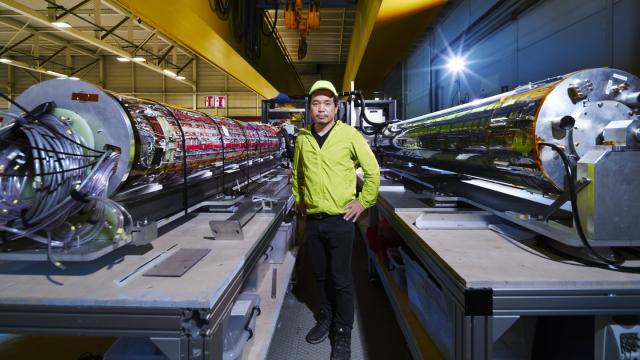For a little more than a week in July 2018, a team of physicists at CERN tried a new technique to slow down antimatter particles zipping around at breakneck speeds. Those 10 days of observation were the culmination of 10 years of development in an international collaboration called ALPHA, which oversaw the design and construction of a high-powered laser. The physicists announced today that their laser could slow down the antimatter significantly, bringing its temperature close to absolute zero.
The team’s research is published today in Nature. Slowing down antimatter is crucial for better understanding how the laws of governing regular matter behave differently when dealing with its inverse. Antimatter is sort of a mirror of matter; the same particles but with opposite charges. Regular-matter electrons have a negative charge; antimatter positrons are positively charged. Then you’ve got positively charged protons and negatively charged antiprotons, and so on. Antimatter and matter annihilate each another when they come into contact, but thankfully the minuscule amounts produced at CERN pose no threat to us.
[referenced id=”1014107″ url=”https://gizmodo.com.au/2016/12/antimatter-looks-surprisingly-like-regular-matter/” thumb=”https://gizmodo.com.au/wp-content/uploads/2016/12/20/gju0novsiwy2pvgfbcgg-300×187.jpg” title=”Antimatter Looks Surprisingly Like Regular Matter” excerpt=”Scientists just learned something crazy about antimatter: it turns out, as far as we can tell, it looks like an exact mirror image of regular matter.”]
In the 93 years we’ve known about antimatter, our ability to experiment with the material has advanced considerably. Now in its second phase, the ALPHA project tinkers with antihydrogen atoms — literally, a positron orbiting an antiproton, just as an electron orbits a proton in regular hydrogen. Antihydrogen, first captured in 2011, is a prime candidate for such experimentation because it is the simplest antiatom.
“Slowing down the motion of antiatoms allows us to perform more precise measurements on its properties. In daily life, you can imagine things moving fast are harder to see than things moving slowly,” said Makoto Fujiwara, a particle physicist with Canada’s TRIUMF particle accelerator team, in a video call. “The same thing happens in quantum physics…. The more time you have to observe a certain property, the more precise your measurement.”
When trapped, the antihydrogen is moving about as fast as a top-speed Lamborghini Gallardo, just over 322 km per hour, Fujiwara said. The physicists bombarded the antiatoms with photons, or light particles, shot from a laser.
“Once the photon hits the atoms, it excites the atoms, but it also changes their motion,” said Takamasa Momose, an atomic molecular spectroscopist affiliated with the project, and who built the laser, in a video call. “What we did was we controlled the light such that we only excited atoms that were approaching the photons, and decelerated them.”
The researchers used the bombardment technique, called laser cooling, to slow down the antiatoms by an order of magnitude, to about the speed of a cheetah, thus reducing their temperature. Sub-atomic photons are basically the ammunition for this laser gun, and the antiatoms are the targets.
At such extreme cold, it was easier to take stock of how the particles behaved. Better understanding such behaviour could provide insights into what happened to all the universe’s antimatter, a long-burning question of particle physics. The big question — the perceived asymmetry of the universe, which has way more matter than antimatter — hinges on understanding how bigger and bigger antimatter structures work when compared to their regular-matter counterparts.
Down the proverbial road (which is more like a highway interchange, given the number of different paths the physicists can go down), Fujiwara and Momose have a range of hopes for further probing of antimatter. There’s the issue of antimatter molecules and how they compare to the ones we see in our daily life. The HAICU project, a Canadian collaboration with CERN set to commence sometime between 2027 and 2036, aims to construct an anti-atomic fountain, with which the team would lob droves of antiatoms into free space and see how they fall.
Preceding HAICU is an ongoing project at CERN to measure gravity’s effect on antimatter, called Alpha-g. “What we’ll do is charge an antihydrogen atom and see how it falls down, and see if it’s exactly the same as normal matter,” Fujiwara said. “If an atom is hot, if they’re moving very fast, when you release them they go everywhere. We can’t see what gravity is doing. But if you make things very slow, they react to gravity more sensitively.”
The researchers hope that questions about the universe’s peculiarities that have long gone unanswered will finally be addressed. Antimatter remains harmless because of how little of it there is. When such structures get more complicated, though, things could get really interesting — imagine entire molecules of antimatter. First things first, though: Let’s get a grip on their physics.
